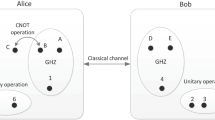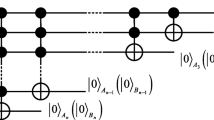Abstract
Bidirectional quantum teleportation is a fundamental protocol for exchanging quantum information between two quantum nodes. Till now, all bidirectional quantum teleportation protocols have achieved a maximum efficiency of \(40\%\). Here, we propose a new scheme for a symmetric bidirectional quantum teleportation using a six-qubit cluster state as the quantum channel, for symmetric (\(3\leftrightarrow 3\)) qubit bidirectional quantum teleportation of a special three-qubit entangled state. The novelty of our scheme lies in its generalisation for (\(N\leftrightarrow N\)) qubit bidirectional quantum teleportation employing a 2N-qubit cluster state. The efficiency of the proposed protocol is remarkably increased to \(50\%\) which is the highest till now. Interestingly, only GHZ-state measurements and four Toffoli-gate operations are necessary which is independent of the number (N) of qubits to be teleported.




Similar content being viewed by others
References
R Horodecki, P Horodecki, M Horodecki and K Horodecki, Rev. Mod. Phys. 81, 865 (2009)
C H Bennett, G Brassard, C Crepeau, R Jozsa, A Peres and W K Wootters, Phys. Rev. Lett. 70, 1895 (1993)
Liu, X Shu, G L Long, D M Tong and F Li, Phys. Rev. A 65, 022304 (2002)
R F Werner, J. Phys. A: Math. Gen. 34, 7081 (2001)
T Sasaki, Y Yamamoto and M Koashi, Nature 509, 475 (2014)
V Scarani, H Bechmann-Pasquinucci, N J Cerf, M Dušek, N Lütkenhaus and M Peev, Rev. Mod. Phys. 81, 1301 (2009)
R Renner, Int. J. Quant. Inf. 6, 1 (2008)
A M Lance, T Symul, W P Bowen, B C Sanders and P K Lam, Phys. Rev. Lett. 92, 177903 (2004)
F Yan and X Zhang, Eur. Phys. J. B 41, 75 (2004)
D Llewellyn, Y Ding, I I Faruque, S Paesani, D Bacco, R Santagati and M G Thompson, Nat. Phys. 16, 148 (2020)
Q C Sun, Y L Mao, S J Chen, W Zhang, Y F Jiang, Y B Zhang and J W Pan, Nat. Photon. 10, 671 (2016)
J L O’brien, Science 318, 1567 (2007)
Y F Huang, X F Ren, Y S Zhang, L M Duan and G C Guo, Phys. Rev. Lett. 93, 240501 (2004)
Y Wan, D Kienzler, S D Erickson, K H Mayer, T R Tan, J J Wu and D Leibfried, Science 364, 875 (2019)
Z X Man, Y J Xia and N B An, Eur. Phys. J. D 42, 333 (2007)
D Bouwmeester, J W Pan, K Mattle, M Eibl, H Weinfurter and A Zeilinger, Nature 390, 575 (1997)
X S Ma, Nature 489, 269 (2012)
X M Jin, Nat. Photon. 4, 376 (2010)
Q Zhang, Nat. Phys. 2, 678 (2006)
S Pirandola, J Eisert, C Weedbrook, A Furusawa and S L Braunstein, Nat. Photon. 9, 641 (2015)
J G Ren, Nature 549, 70 (2017)
K Yang, L Huang, W Yang and F Song, Int. J. Theor. Phys. 48, 516 (2009)
G Rigolin, Phys. Rev. A 71, 032303 (2005)
D F Li, R J Wang and E Baagyere, Quant. Inf. Proc. 18, 1 (2019)
P Agrawal and A K Pati, Phys. Lett. A 305, 12 (2002)
D Saha and P K Panigrahi, Quant. Inf. Proc. 11, 615 (2012)
P Agrawal and A Pati, Phys. Rev. A 74, 062320 (2006)
X W Zha, Z-C Zou, J X Qi and H Y Song, Int. J. Theor. Phys. 52, 1740 (2013)
C Wang, F G Deng and G L Long, Opt. Commun. 15, 253 (2005)
M Hillery, V Bužek and A Berthiaume, Phys. Rev. A 59, 1829 (1999)
D Gottesman, Phys. Rev. A 61, 042311 (2000)
N Srinatha, S Omkar, R Srikanth, S Banerjee and A Pathak, Quant. Inf. Proc. 13, 59 (2014)
C Shukla, A Banerjee and A Pathak, Int. J. Theor. Phys. 52, 3790 (2013)
Y Chen, Int. J. Theor. Phys. 53, 1454 (2014)
Y J Duan, X W Zha, X M Sun and J F Xia, Int. J. Theor. Phys. 53, 2697 (2014)
M H Sang, Int. J. Theor. Phys. 55, 380 (2016)
R G Zhou, C Qian and H Ian, IEEE Access 7, 42445 (2019)
M Sang, Int. J. Theor. Phys. 55, 1333 (2016)
M S S Zadeh, M Houshmand and H Aghababa, Int. J. Theor. Phys. 56, 2101 (2017)
J Chen, D Li, M Liu and Y Yang, IEEE Access 8, 28925 (2020)
R G Zhou, R Xu and H Lan, IEEE Access 8, 44269 (2019)
V Verma, IEEE Commun. Lett. 25, 936 (2020)
V Verma, Phys. Scr. 95, 115101 (2020)
S Hassanpour and M Houshmand, Quant. Inf. Proc. 15, 905 (2016)
R G Zhou, X Li, C Qian and H Ian, Int. J. Theor. Phys. 59, 166 (2020)
M Schlosshauer, Rev. Mod. Phys. 76, 1267 (2005)
W H Zurek, Phys. Today 44, 36 (1991)
H J Briegel and R Raussendorf, Phys. Rev. Lett. 86, 910 (2001)
M Q Lone, A Dey and S Yarlagadda, Solid State Commun. 202, 73 (2015)
A Farouk et al, Front. Phys. 13, 130306 (2018)
P Espoukeh and P Pedram, Quant. Inf. Proc. 13, 1789 (2014)
C Jiang,Y Z Wei and M Jiang, Int. J. Theor. Phys. 61, 1 (2022)
S Oh, S Lee and H W Lee, Phys. Rev. A 66, 022316 (2002)
D F Li, R J Wang, F L Zhang, E Baagyere, Z Qin, H Xiong and H Zhan, Quant. Inf. Proc. 15, 4819 (2016)
M S Sadeghi-Zadeh, M Houshmand, H Aghababa, M H Kochakzadeh and F Zarmehi, Quant. Inf. Proc. 18, 1 (2019)
Y H Li and X M Jin, Quant. Inf. Proc. 15, 929 (2016)
R Dai and H S Li, Int. J. Theor. Phys. 61, 1 (2022)
J Malik, M Lone and R Malla, to be published
Author information
Authors and Affiliations
Corresponding author
Appendix A. Construction of six-qubit entangled channel on IBM quantum composer platform
Appendix A. Construction of six-qubit entangled channel on IBM quantum composer platform
In our proposed BQT scheme, utilising the six-qubit cluster state as the quantum channel, bilateral transmission of a special three-qubit state is achieved. Here, the construction of the six-qubit entangled quantum channel is presented using two H gates and four CNOT gates from single-qubit states. The corresponding quantum circuit as shown in figure 3 is developed on IBM quantum composer making it practically realisable.
The six-qubit channel is constructed from the joint state of six single-qubit states as an input in (3).
The construction of the quantum channel is as follows:
1. Hadamard gate (H) is applied on qubits 1 and 4, and the corresponding state is
2. Four CNOT gates are applied on qubit pairs (1,2), (2,3), (4,5) and (5,6) with the first qubit being the control and the second target to get the required six qubit entangled state.
This six-qubit quantum channel constructed on the IBM quantum composer platform (eq. (A.3)) can also be represented by the amplitude of the corresponding computational basis states as shown in figure 4.
Rights and permissions
About this article
Cite this article
Malik, J.A., Lone, M.Q. & Malla, R.A. Symmetric bidirectional quantum teleportation using a six-qubit cluster state as a quantum channel. Pramana - J Phys 97, 50 (2023). https://doi.org/10.1007/s12043-023-02521-4
Received:
Revised:
Accepted:
Published:
DOI: https://doi.org/10.1007/s12043-023-02521-4
Keywords
- Bidirectional quantum teleportation
- six-qubit cluster state
- GHZ-state measurements
- Toffoli-gate operations




